Frequency-Spectra-Based High Coding Capacity Chipless RFID Using an UWB-IR Approach
Abstract
1. Introduction
2. Operating Principles of the Chipless Radio Frequency Identification (RFID) Reader System
2.1. Chipless Radio Frequency Identification (RFID) Reader System
2.2. Design of Ultra-Wideband (UWB) Reader Antenna
2.3. Chipless Tag Antenna Design and Operation
3. Model of Chipless RFID System for Backscatter
3.1. Chipless Tag Interrogation and Backscatter Response
3.2. Analysis of Chipless Tag Backscatter Response
3.3. Tag Performance in Detection of Different Bits
4. Experimental Validation in the Anechoic Chamber
4.1. Reader Antenna and Chipless RFID Tag Measurement Results
4.2. Parametric Study of Orientation of Chipless Tag
5. Conclusions
Author Contributions
Funding
Institutional Review Board Statement
Informed Consent Statement
Data Availability Statement
Acknowledgments
Conflicts of Interest
References
- Athauda, K.; Karmakar, N. Chipped versus chipless RF identification. IEEE Microw. Mag. 2019, 20, 47–57. [Google Scholar] [CrossRef]
- Abdulkawi, W.M.; Issa, K.; Sheta, A.F.A.; Alshebeili, S.A. A novel printable tag of M-shaped strips for chipless radio-frequency identification in IoT applications. Electronics 2020, 9, 2116. [Google Scholar] [CrossRef]
- Added, M.; Boulejfen, N.; Svanda, M.; Ghannouchi, F.M.; Vuong, T.P. High-performance chipless radio-frequency identification tags. IEEE Antennas Propag. Mag. 2019, 61, 46–54. [Google Scholar] [CrossRef]
- Babaeian, F.; Karmakar, N.C. Development of cross-polar orientation-insensitive chipless RFID tags. IEEE Trans. Antennas Propag. 2020, 68, 5159–5170. [Google Scholar] [CrossRef]
- Necibi, O.; Guesmi, C.; Naoui, S.; Gharsallah, A. A novel electromagnetic signature based on RF identification of numbers. Int. J. Commun. Antenna Propag. 2016, 6, 400–405. [Google Scholar] [CrossRef]
- Sakouhi, S.; Raggad, H.; Gharsallah, A.; Latrach, M. A novel RFID EMSICC-based chipless tag. Radioengineering 2017, 57, 154–161. [Google Scholar] [CrossRef]
- Shrestha, S.; Karmakar, N.C. Analysis of real-world implementation challenges of chipless RFID tag. IET Microw. Antennas Propag. 2019, 13, 1318–1324. [Google Scholar] [CrossRef]
- Babaeian, F.; Karmakar, N.C. Time and frequency domains analysis of chipless RFID back-scattered tag reflection. IoT 2020, 1, 109–127. [Google Scholar] [CrossRef]
- Mekki, K.; Necibi, O.; Boussetta, C.; Gharsallah, A. Miniaturization of circularly polarized patch antenna for RFID reader applications. Eng. Technol. Appl. Sci. Res. 2020, 10, 5655–5659. [Google Scholar] [CrossRef]
- Mekki, K.; Necibi, O.; Gharsallah, A. Design of a miniaturized dipole RFID tag antenna. Indian J. Sci. Technol. 2020, 13, 3103–3112. [Google Scholar] [CrossRef]
- Prabavathi, P.; Rani, S.; Meena, G. Spectral signature based chipless RFID tag loaded by meandered line multi-resonator. Prog. Electromagn. Res. C 2020, 100, 121–131. [Google Scholar] [CrossRef][Green Version]
- Ma, Z.; Jiang, Y. High-density 3D printable chipless RFID tag with structure of passive slot rings. Sensors 2019, 19, 2535. [Google Scholar] [CrossRef] [PubMed]
- Svanda, M.; Polivka, M.; Havlicek, J.; Machac, J.; Werner, D.H. Platform tolerant, high encoding capacity dipole array-plate chipless RFID tags. IEEE Access 2017, 7, 138707–138720. [Google Scholar] [CrossRef]
- Chen, Y.S.; Jiang, T.Y.; Lai, F.P. Design rule development for frequency-coded chipless radiofrequency identification with high capacity. IET Microw. Antennas Propag. 2019, 13, 1255–1261. [Google Scholar] [CrossRef]
- Rmili, H.; Oussama, B.; Yousaf, J.; Hakim, B.; Mittra, R.; Aguili, T.; Tedjini, S. Robust detection for chipless RFID tags based on compact printable alphabets. Sensors 2019, 19, 4785. [Google Scholar] [CrossRef] [PubMed]
- Abdulkawi, W.M.; Sheta, A.A. High coding capacity chipless radiofrequency identification tags. Microw. Opt. Technol. Lett. 2019, 62, 592–599. [Google Scholar] [CrossRef]
- Li, H.; Wang, B.; Wu, M.; Zhu, J.; Zhou, C. Design and analysis of chipless RFID tags based on retro-radiators. IEEE Access 2019, 7, 148208–148217. [Google Scholar] [CrossRef]
- Zhang, Y.J.; Gao, R.X.; He, H.; Tong, M.S. Effective design of microstrip-line chipless RFID tags based on filter theory. IEEE Trans. Antennas Propag. 2018, 67, 1428–1436. [Google Scholar] [CrossRef]
- Barbot, N.; Perret, E. Accurate positioning system based on chipless technology. Sensors 2019, 19, 1341. [Google Scholar] [CrossRef]
- Athauda, T.; Karmakar, N.C. The realization of chipless RFID resonator for multiple physical parameter sensing. IEEE Internet Things J. 2019, 6, 5387–5396. [Google Scholar] [CrossRef]
- Jalil, M.E.; Rahim, M.K.; Samsuri, N.A.; Dewan, R. Flexible printed chipless RFID tag using metamaterial–split ring resonator. Appl. Phys. A 2016, 122, 348. [Google Scholar] [CrossRef]
- Vena, A.; Perret, E.; Tedjini, S. High-capacity chipless RFID tag insensitive to the polarization. IEEE Trans. Antennas Propag. 2012, 60, 4509–4515. [Google Scholar] [CrossRef]
- Huang, H.; Su, L. A compact dual-polarized chipless RFID tag by using nested concentric square loops. IEEE Antennas Wirel. Propag. Lett. 2017, 16, 1036–1039. [Google Scholar] [CrossRef]
- Costa, F.; Genovesi, S.; Monorchio, A. Chipless RFIDs for metallic objects by using cross polarization encoding. IEEE Trans. Antennas Propag. 2014, 62, 4402–4407. [Google Scholar] [CrossRef]
- Costa, F.; Genovesi, S.; Monorchio, A. Normalization-free chipless RFIDs by using dual-polarized interrogation. IEEE Trans. Microw. Theory Tech. 2016, 64, 310–318. [Google Scholar] [CrossRef]
- Polivka, M.; Havlicek, J.; Svanda, M.; Machac, J. Improvement in robustness and recognizability of RCS response of U-shaped strip-based chipless RFID tags. IEEE Antennas Wirel. Propag. Lett. 2016, 15, 2000–2003. [Google Scholar] [CrossRef]
- Svanda, M.; Polivka, M.; Havlicek, J.; Machac, J. Chipless RFID tag with an improved magnitude and robustness of RCS response. Microw. Opt. Technol. Lett. 2017, 59, 488–492. [Google Scholar] [CrossRef]
- Havlicek, J.; Svanda, M.; Polivka, M.; Machac, J.; Kracek, J. Chipless RFID tag based on electrically small spiral capacitively loaded dipole. IEEE Antennas Wirel. Propag. Lett. 2017, 16, 3051–3054. [Google Scholar] [CrossRef]
- Rance, O.; Siragusa, R.; Lemaître-Auger, P.; Perret, E. Toward RCS magnitude level coding for chipless RFID. IEEE Trans. Microw. Theory Tech. 2016, 64, 2315–2325. [Google Scholar] [CrossRef]
- Antayhua, R.A.R.; Rambo, C.R.; De Sousa, F.R. Miniaturized chipless sensor with magnetically coupled transducer for improved RCS. IEEE Microw. Wirel. Compon. Lett. 2017, 27, 718–720. [Google Scholar] [CrossRef]
- Issa, K.; Alshoudokhi, A.Y.; Ashraf, M.A.; AlShareef, M.R.; Behairy, M.H.; Alshebeili, S.; Fathallah, H. A high-density L-shaped backscattering chipless tag for RFID bistatic systems. Int. J. Antennas Propag. 2018, 2018, 1542520. [Google Scholar] [CrossRef]
- Sharma, V.; Hashmi, M. Simple chipless RFID tag configurations. In Proceedings of the IEEE Asia-Pacific Conference on Antennas and Propagation (APCAP), Auckland, New Zealand, 5–8 August 2018; pp. 347–348. [Google Scholar]
- Ramos, A.; Perret, E.; Rance, O.; Tedjini, S.; Lázaro, A.; Girbau, D. Temporal separation detection for chipless depolarizing frequency-coded RFID. IEEE Trans. Microw. Theory Tech. 2016, 64, 2326–2337. [Google Scholar] [CrossRef]
- Sharma, V.; Malhotra, S.; Hashmi, M. Slot resonator based novel orientation independent chipless RFID tag configurations. IEEE Sens. J. 2019, 19, 5153–5160. [Google Scholar] [CrossRef]
- Abdulkawi, W.M.; Sheta, A.F.A.; Issa, K.; Alshebeili, S.A. Compact printable inverted-M shaped chipless RFID tag using dual polarization excitation. Electronics 2019, 8, 580. [Google Scholar] [CrossRef]
- Jabeen, A.; Ejaz, A.; Rahman, M.U.; Naghshvarianjahromi, M.; Khan, M.J.; Amin, Y.; Tenhunen, H. Data-dense and miniature chipless moisture sensor RFID tag for Internet of Things. Electronics 2019, 8, 1182. [Google Scholar] [CrossRef]
- Habib, A.; Ansar, S.; Akram, A.; Azam, M.A.; Amin, Y.; Tenhunen, H. Directly printable organic ASK based chipless RFID tag for IoT applications. Radioengineering 2017, 26, 453–460. [Google Scholar] [CrossRef]
- Vena, A.; Babar, A.A.; Sydänheimo, L.; Tentzeris, M.M.; Ukkonen, L. A novel near-transparent ASK-reconfigurable inkjet-printed chipless RFID tag. IEEE Antennas Wirel. Propag. Lett. 2013, 12, 753–756. [Google Scholar] [CrossRef]
- Betancourt, D.; Haase, K.; Hübler, A.; Ellinger, F. Bending and folding effect study of flexible fully-printed and late-stage codified octagonal chipless RFID tags. IEEE Trans. Antennas Propag. 2016, 64, 2815–2823. [Google Scholar] [CrossRef]
- Paredes, F.; Herrojo, C.; Escudé, R.; Ramon, E.; Martín, F. High data density near-field chipless-RFID tags with synchronous reading. IEEE J. Radio Freq. Identif. 2020, 4, 517–524. [Google Scholar] [CrossRef]
- Herrojo, C.; Paredes, F.; Bonache, J.; Martín, F. 3-D-printed high data-density electromagnetic encoders based on permittivity contrast for motion control and chipless-RFID. IEEE Trans. Microw. Theory Tech. 2020, 68, 1839–1850. [Google Scholar] [CrossRef]
- Laura, C.; Giuseppina, M.; Tarricone, L. A frequency signature RFID chipless tag for wearable applications. Sensors 2019, 19, 494. [Google Scholar]
- Laura, C.; Giuseppina, M.; Egidio, D.B.; Andrea, C.; Leopoldo, A.; Pasquale, A.; Luciano, T. Fully-textile, wearable chipless tags for identification and tracking applications. Sensors 2020, 20, 429. [Google Scholar]
- Terranova, S.; Costa, F.; Manara, G.; Genovesi, S. Three-dimensional chipless RFID tags: Fabrication through additive manufacturing. Sensors 2020, 20, 4740. [Google Scholar] [CrossRef] [PubMed]
- Ashraf, M.A.; Alshoudokhi, Y.A.; Behairy, H.M.; Alshareef, M.R.; Alshebeili, S.A.; Issa, K.; Fathallah, H. Design and analysis of multi-resonators loaded broadband antipodal tapered slot antenna for chipless RFID applications. IEEE Access 2017, 5, 25798–25807. [Google Scholar] [CrossRef]
- Herrojo, C.; Paredes, F.; Mata-Contreras, J.; Martín, F. Chipless-RFID: A review and recent developments. Sensors 2019, 19, 3385. [Google Scholar] [CrossRef]
- Herrojo, C.; Mata-Contreras, J.; Núñez, A.; Paredes, F.; Ramon, E.; Martín, F. Near-field chipless-RFID system with high data capacity for security and authentication applications. IEEE Trans. Microw. Theory Tech. 2017, 6, 5298–5308. [Google Scholar] [CrossRef]
- Riaz, M.A.; Shahid, H.; Aslam, S.Z.; Amin, Y.; Akram, A.; Tenhunen, H. Novel T-shaped resonator based chipless RFID tag. IEICE Electron. Express 2017, 14, 20170728. [Google Scholar] [CrossRef][Green Version]
- Kracek, J.; Svanda, M.; Hoffmann, K. Scalar method for reading of chipless RFID tags based on limited ground plane backed dipole resonator array. IEEE Trans. Microw. Theory Tech. 2019, 67, 4547–4558. [Google Scholar] [CrossRef]
- Alam, J.; Khaliel, M.; Fawky, A.; El-Awamry, A.; Kaiser, T. Frequency-coded chipless RFID tags: Notch model, detection, angular orientation, and coverage measurements. Sensors 2020, 20, 1843. [Google Scholar] [CrossRef]
- Kalansuriya, P.; Karmakar, N. UWB-IR based detection for frequency-spectra based chipless RFID. In Proceedings of the IEEE MTT-S International Microwave Symposium Digest, Montreal, QC, Canada, 17–22 June 2012. [Google Scholar]
- Karmakar, N.C. Tag, You’re It! IEEE Microw. Mag. 2016, 17, 64–74. [Google Scholar]
- Hashmi, M.S.; Sharma, V. Design, analysis, and realisation of chipless RFID tag for orientation independent configurations. J. Eng. 2020, 2020, 189–196. [Google Scholar] [CrossRef]
- Michele, B.; Filippo, C.; Simone, G.; Giuliano, M. Depolarizing chipless tags with polarization insensitive capabilities. Electronics 2021, 10, 478. [Google Scholar]
- Mekki, K.; Boussetta, C.; Gharsallah, A. Design and miniaturization of UHF RFID reader antenna. In Proceedings of the 18th Mediterranean Microwave Symposium (MMS), Istanbul, Turkey, 31 October–2 November 2018. [Google Scholar]
- Anee, R.E.A.; Karmakar, N.C. Chipless RFID tag localization. IEEE Trans. Microw. Theory Tech. 2013, 61, 4008–4017. [Google Scholar] [CrossRef]
- El-Hadidy, M.; El-Awamry, A.; Fawky, A.; Khaliel, M.; Kaiser, T. Real-world testbed for multi-tag UWB chipless RFID system based on a novel collision avoidance MAC protocol. Trans. Emerg. Telecommun. Technol. 2016, 27, 1707–1714. [Google Scholar] [CrossRef]
- Decarli, N.; Dardari, D. Time domain measurements of signals backscattered by wideband RFID tags. IEEE Trans. Instrum. Meas. 2018, 67, 2548–2560. [Google Scholar] [CrossRef]
- Lakrit, S.; Das, S.; Ghosh, S.; Madhav, B.T.P. Compact UWB flexible elliptical CPW-fed antenna with triple notch bands for wireless communications. Int. J. RF Microw. Comput. Aided Eng. 2020, 30, e22201. [Google Scholar] [CrossRef]
- Aliasgari, J.; Karmakar, N.C. Mathematical model of chipless RFID tags for detection improvement. IEEE Trans. Microw. Theory Tech. 2020, 68, 4103–4115. [Google Scholar] [CrossRef]
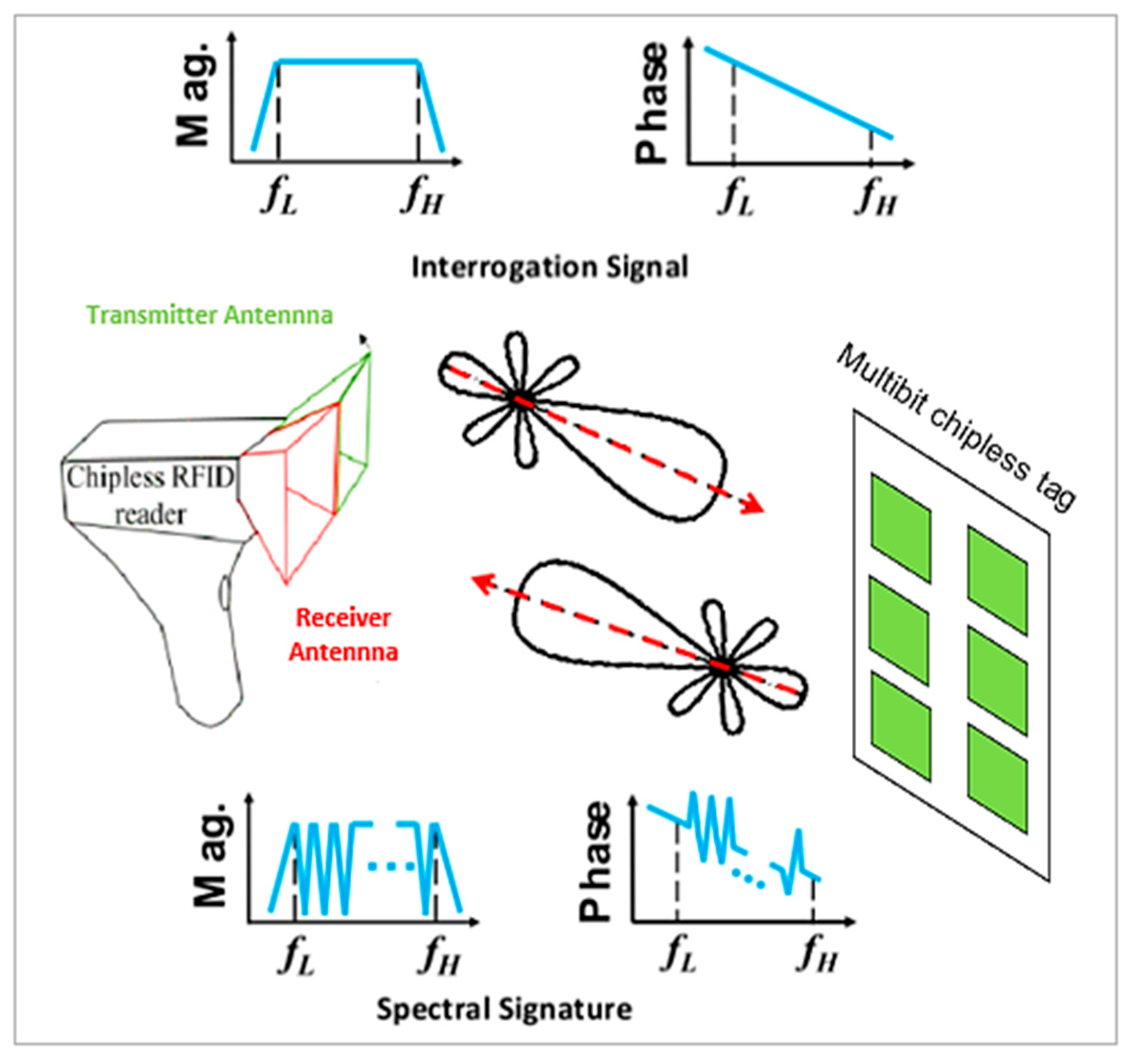
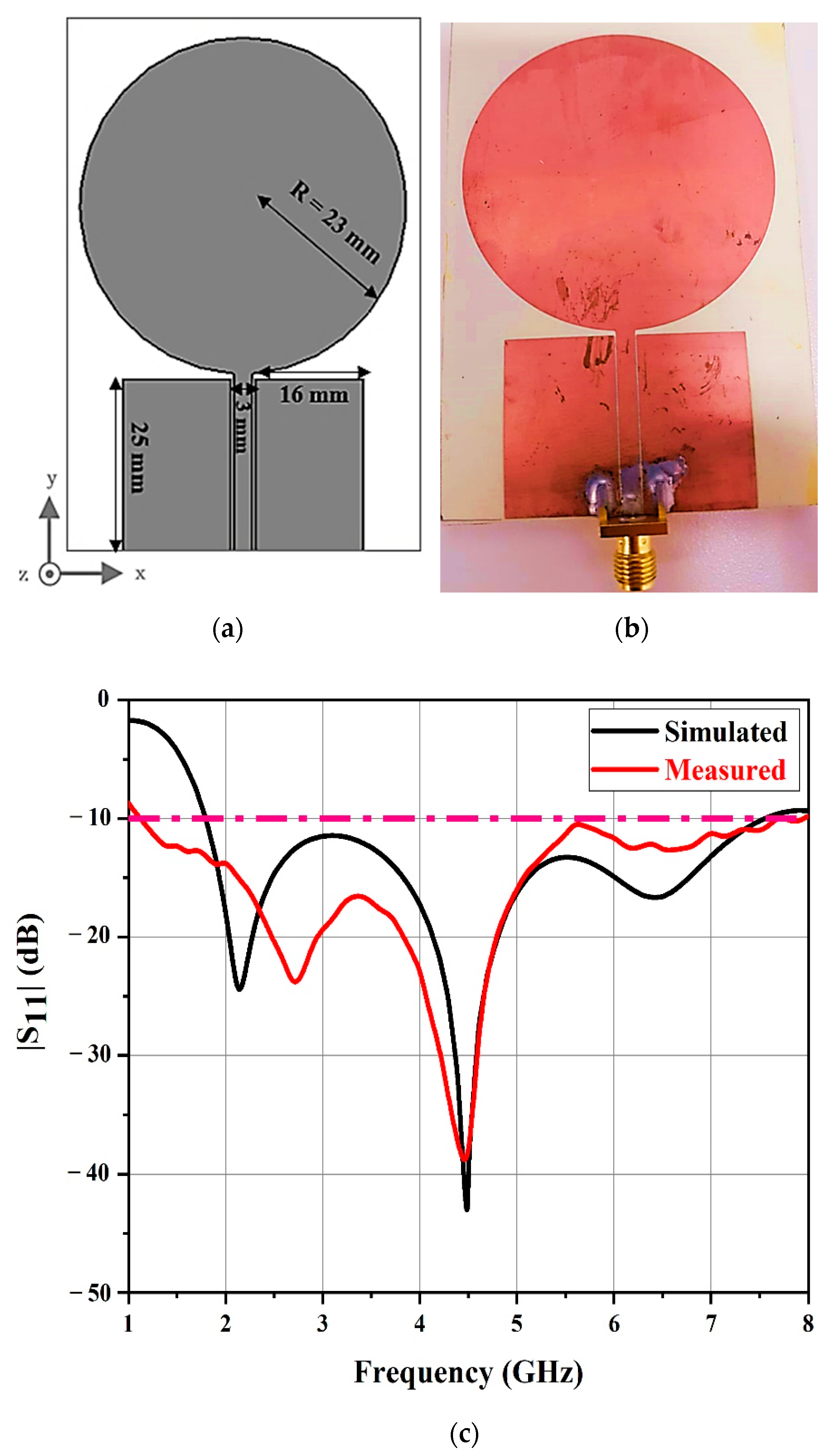

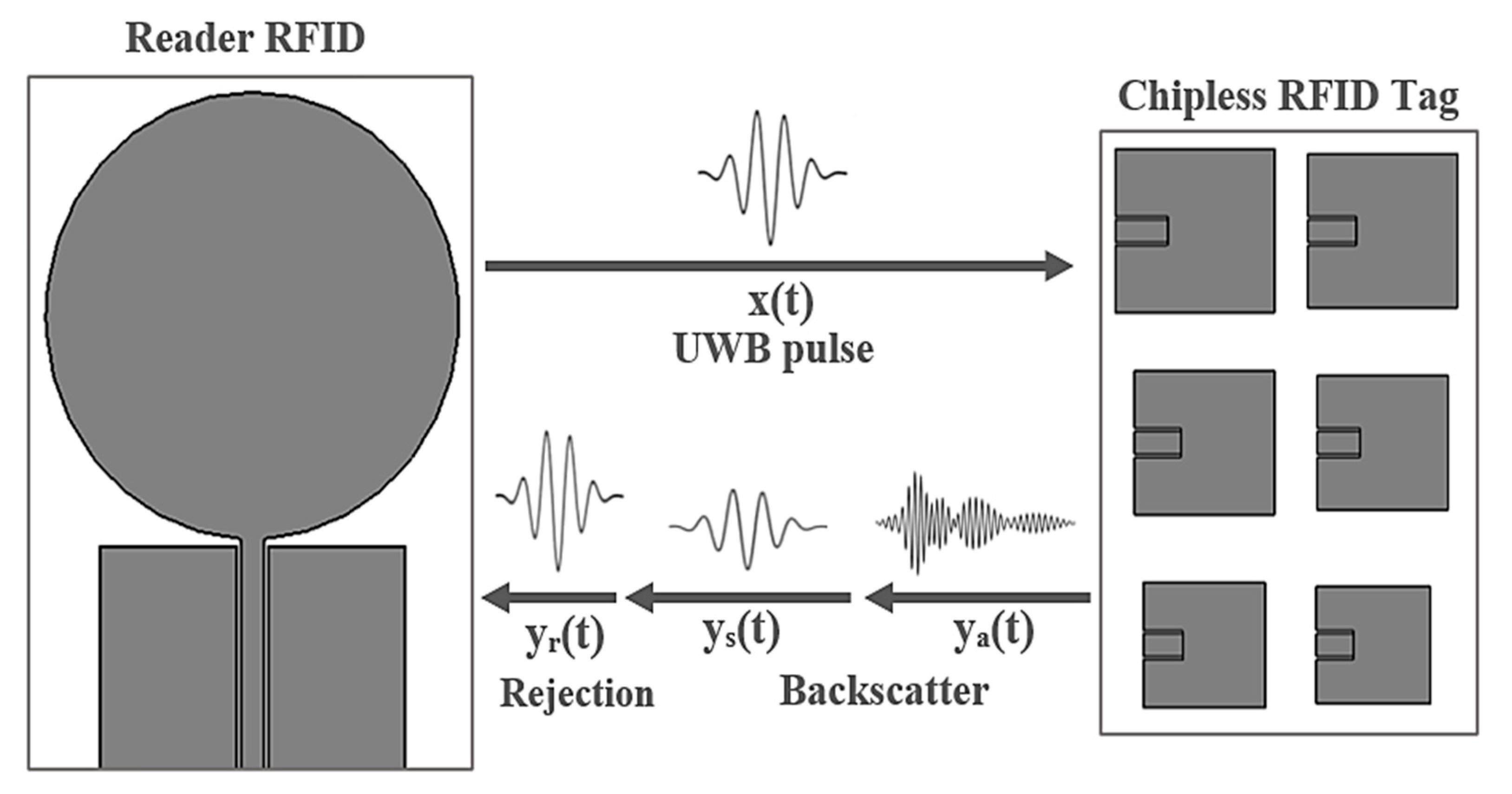

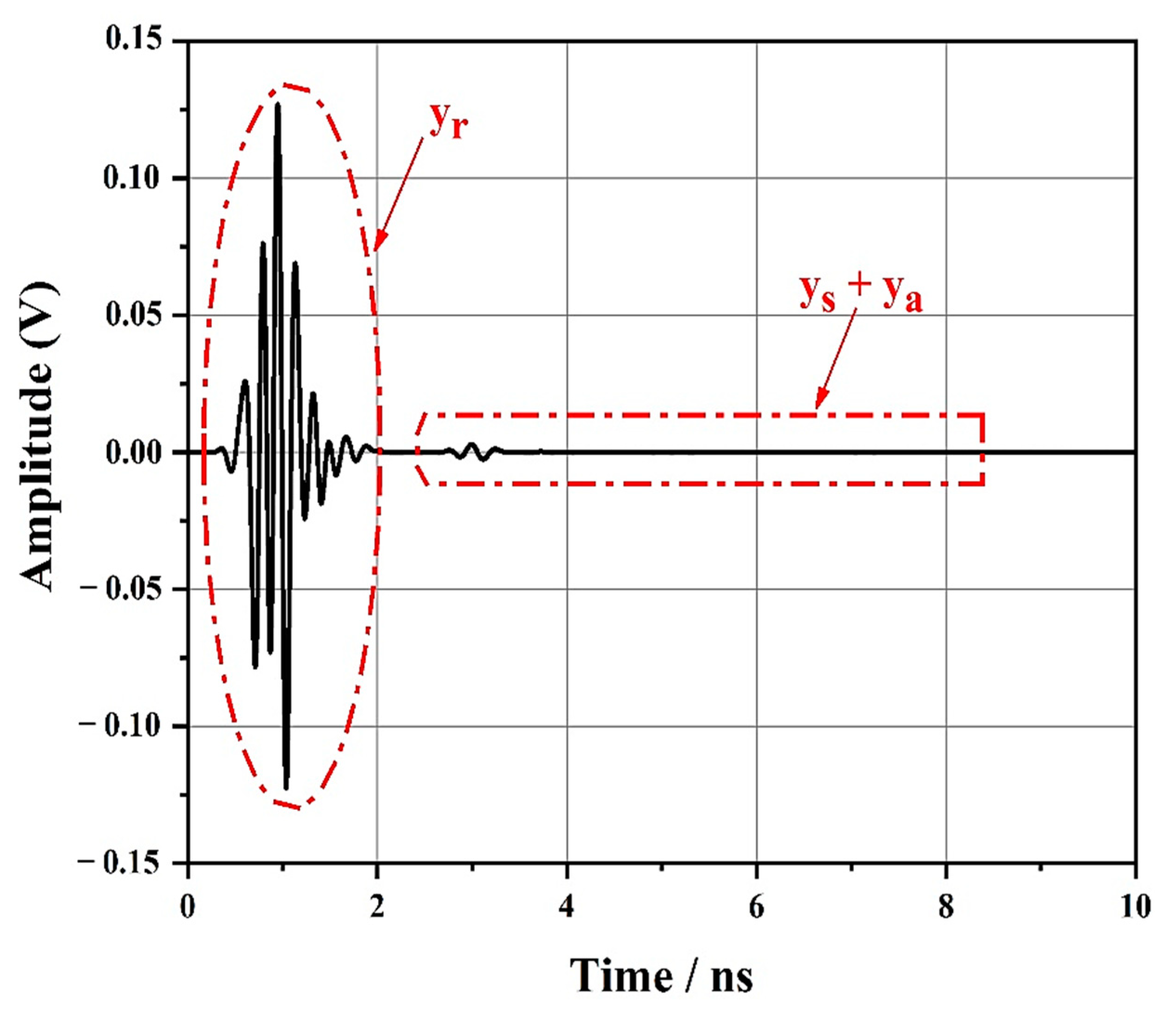
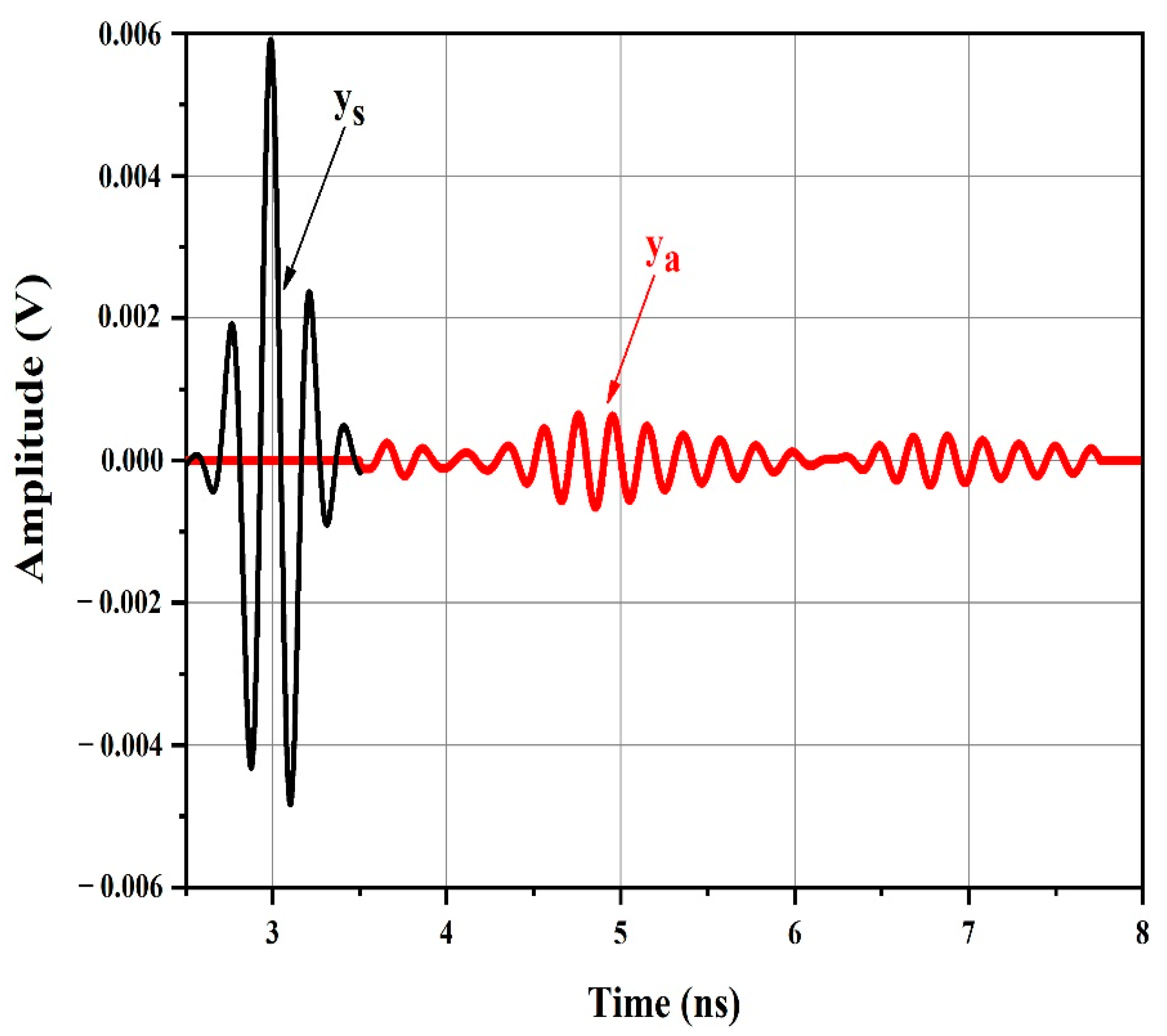
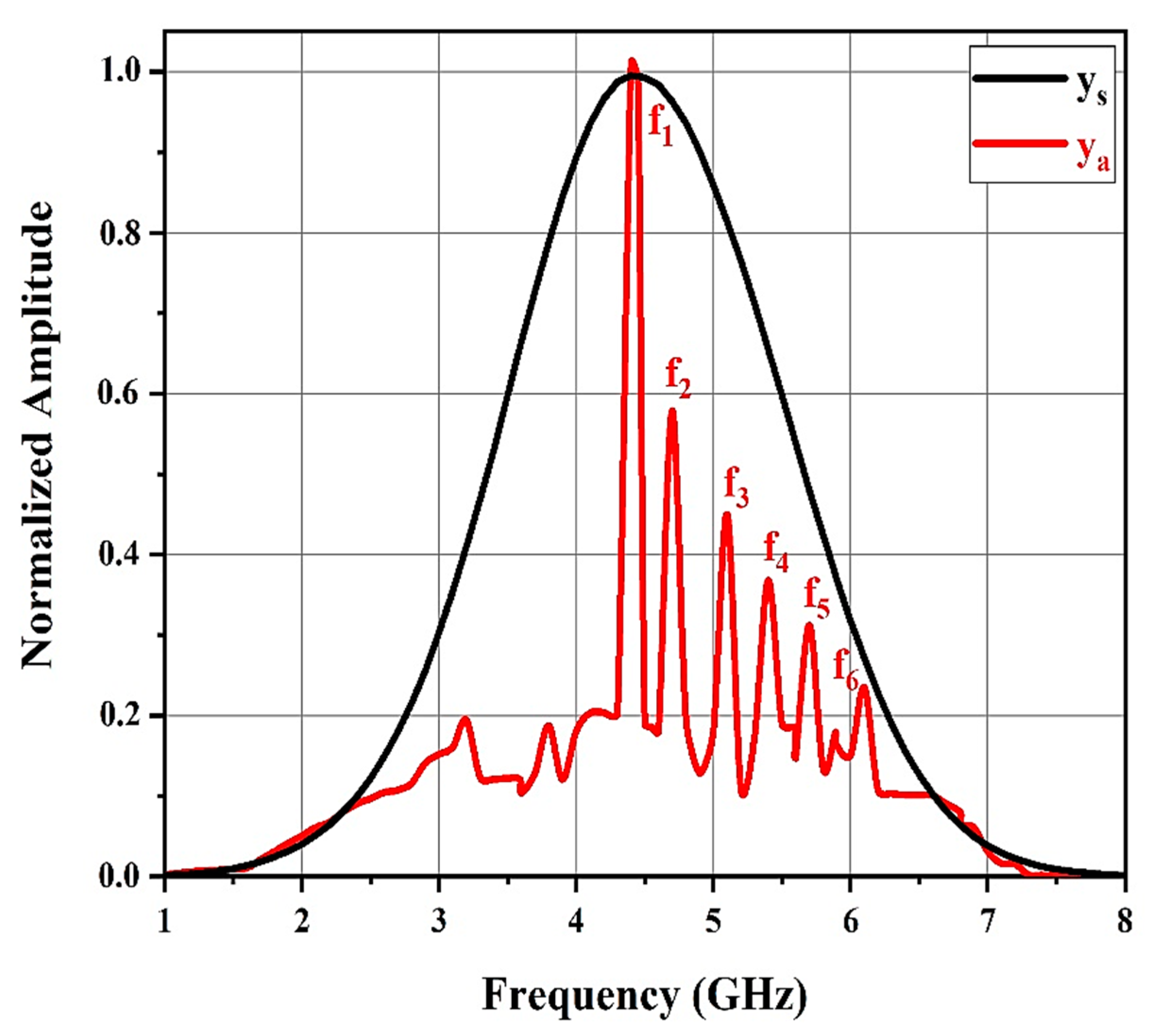
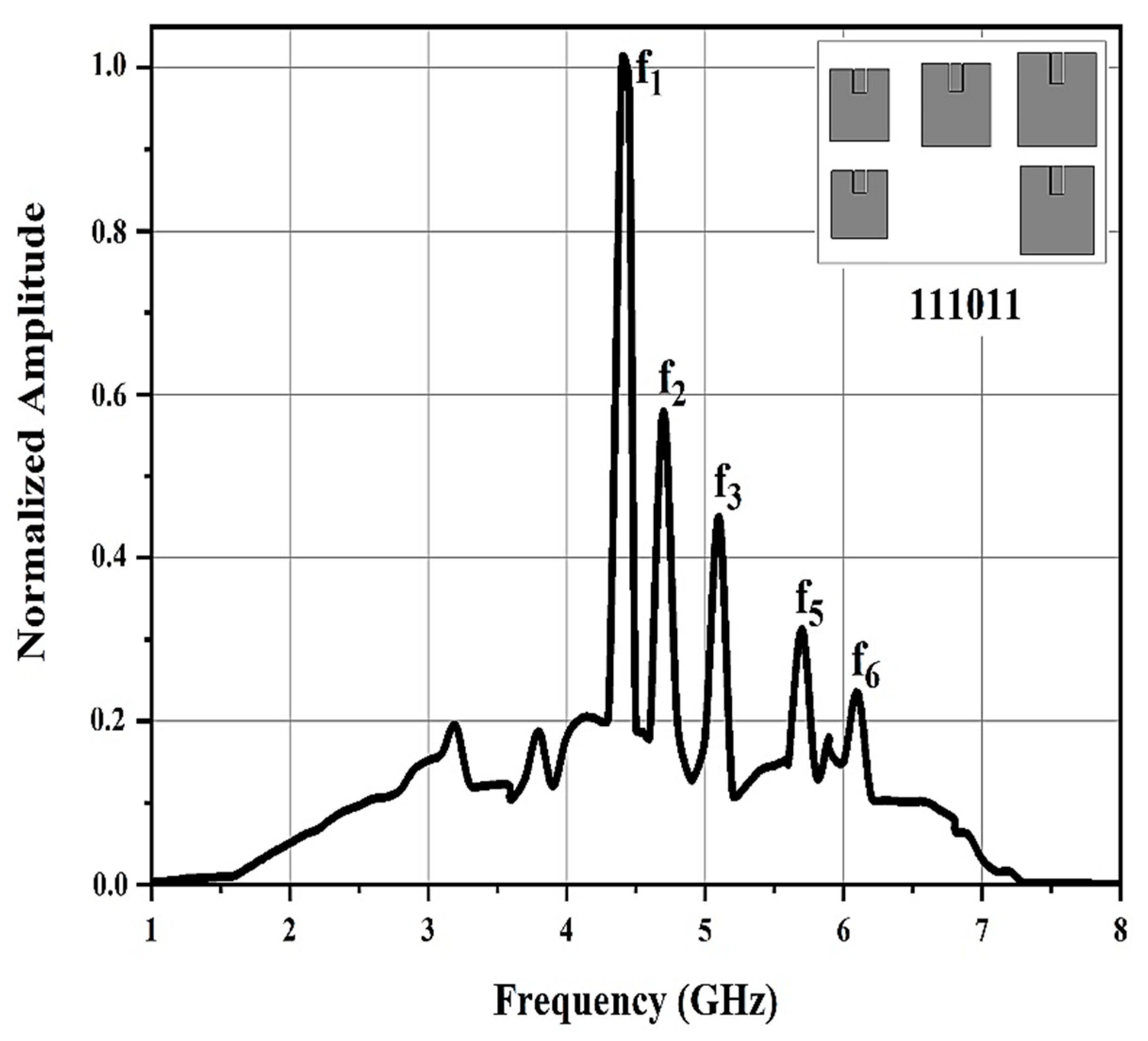
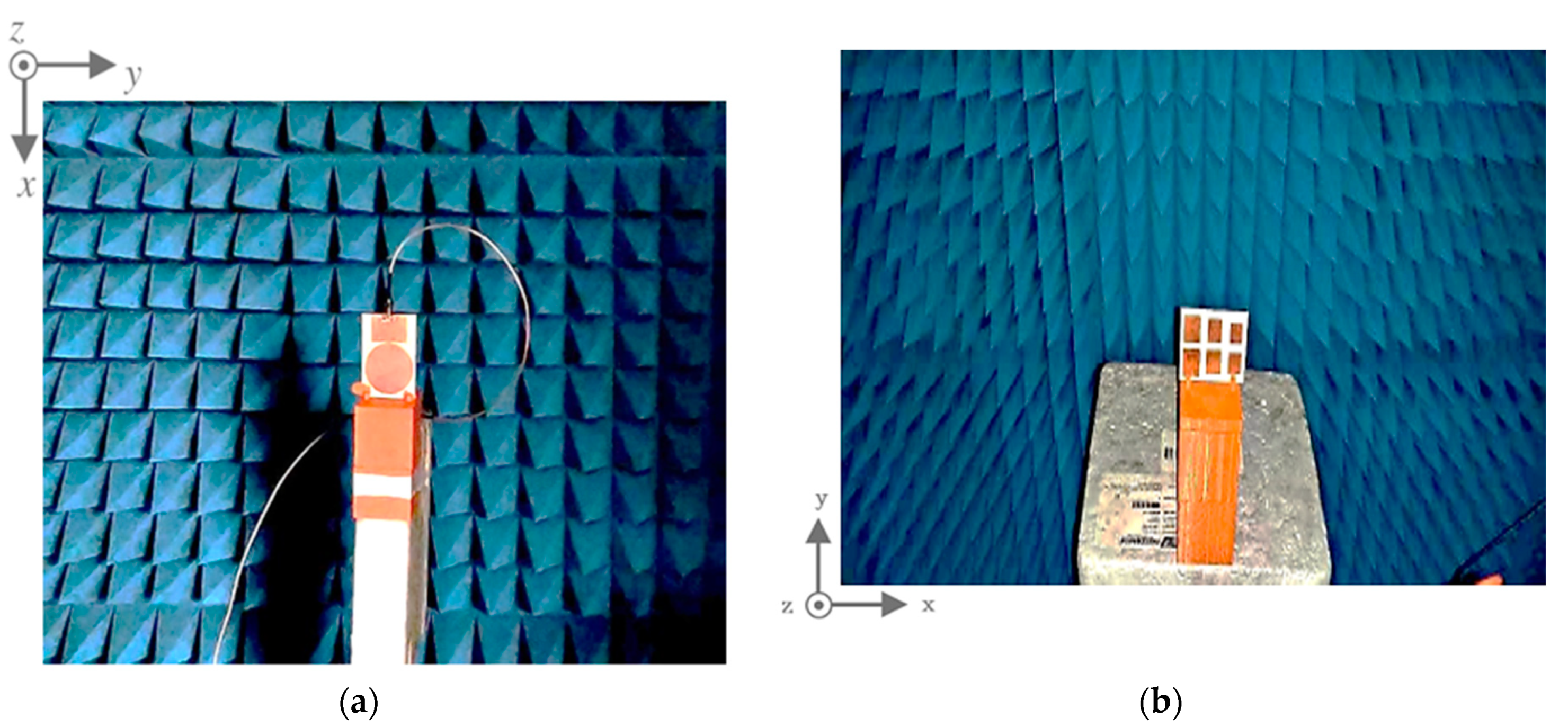
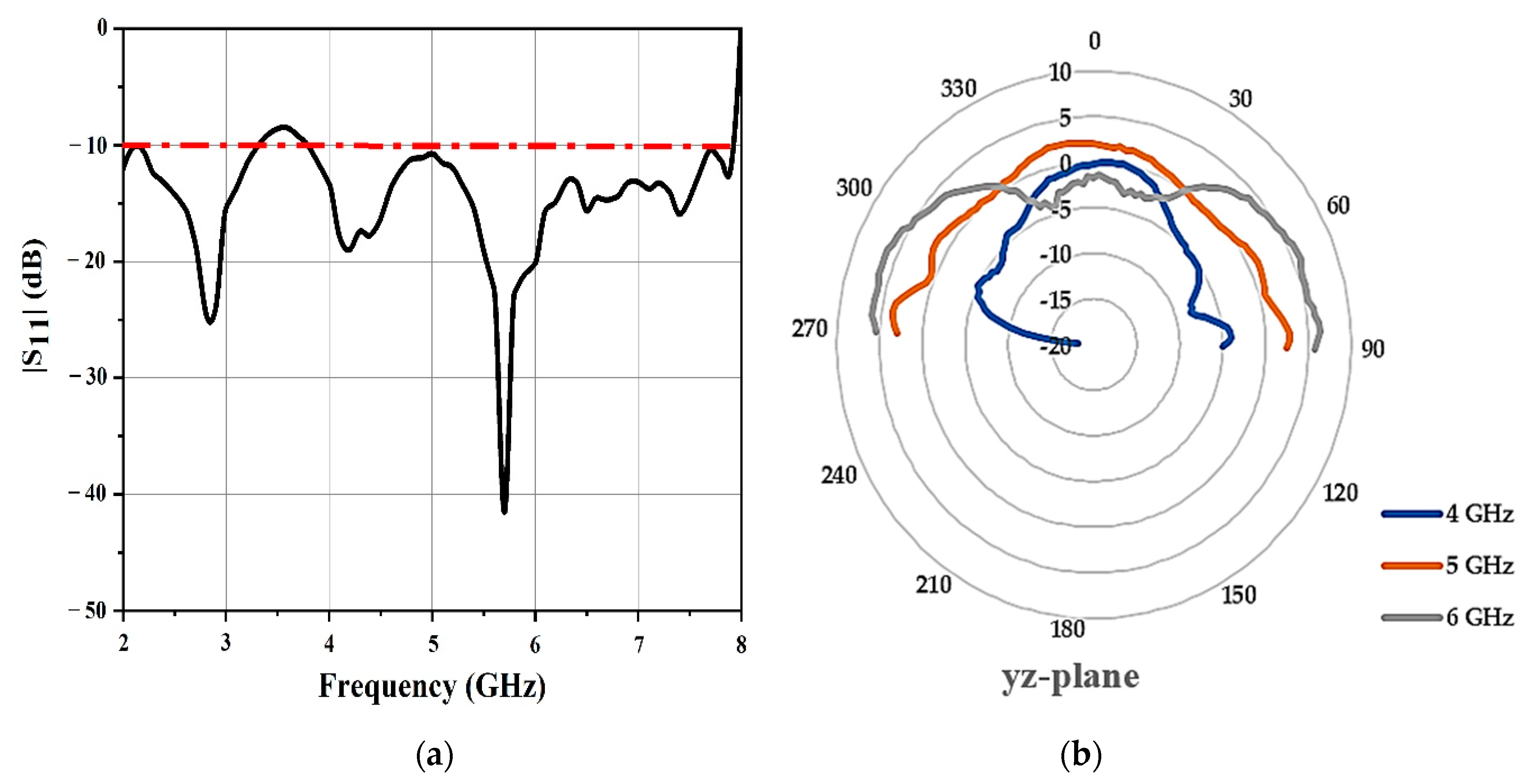
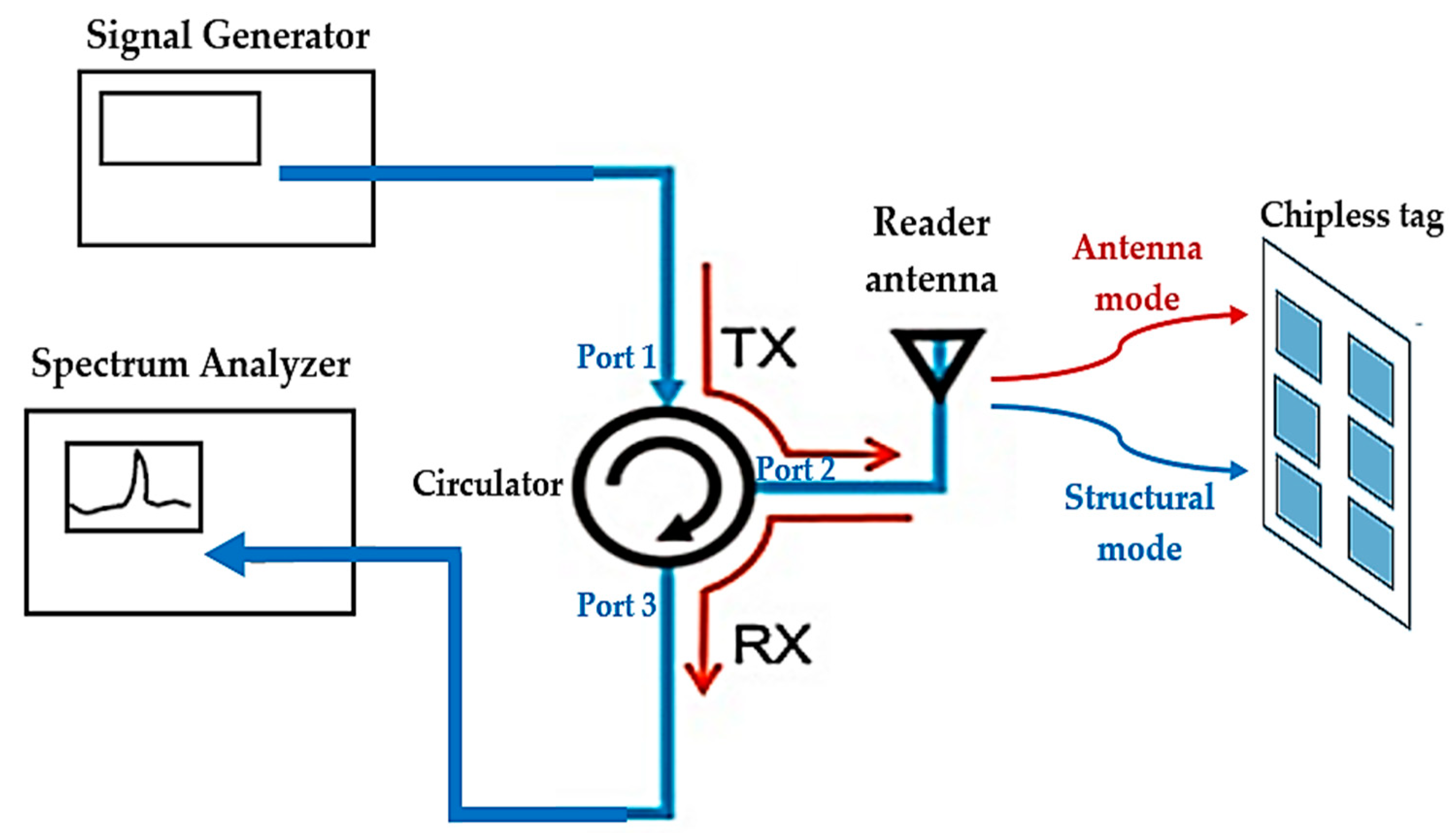
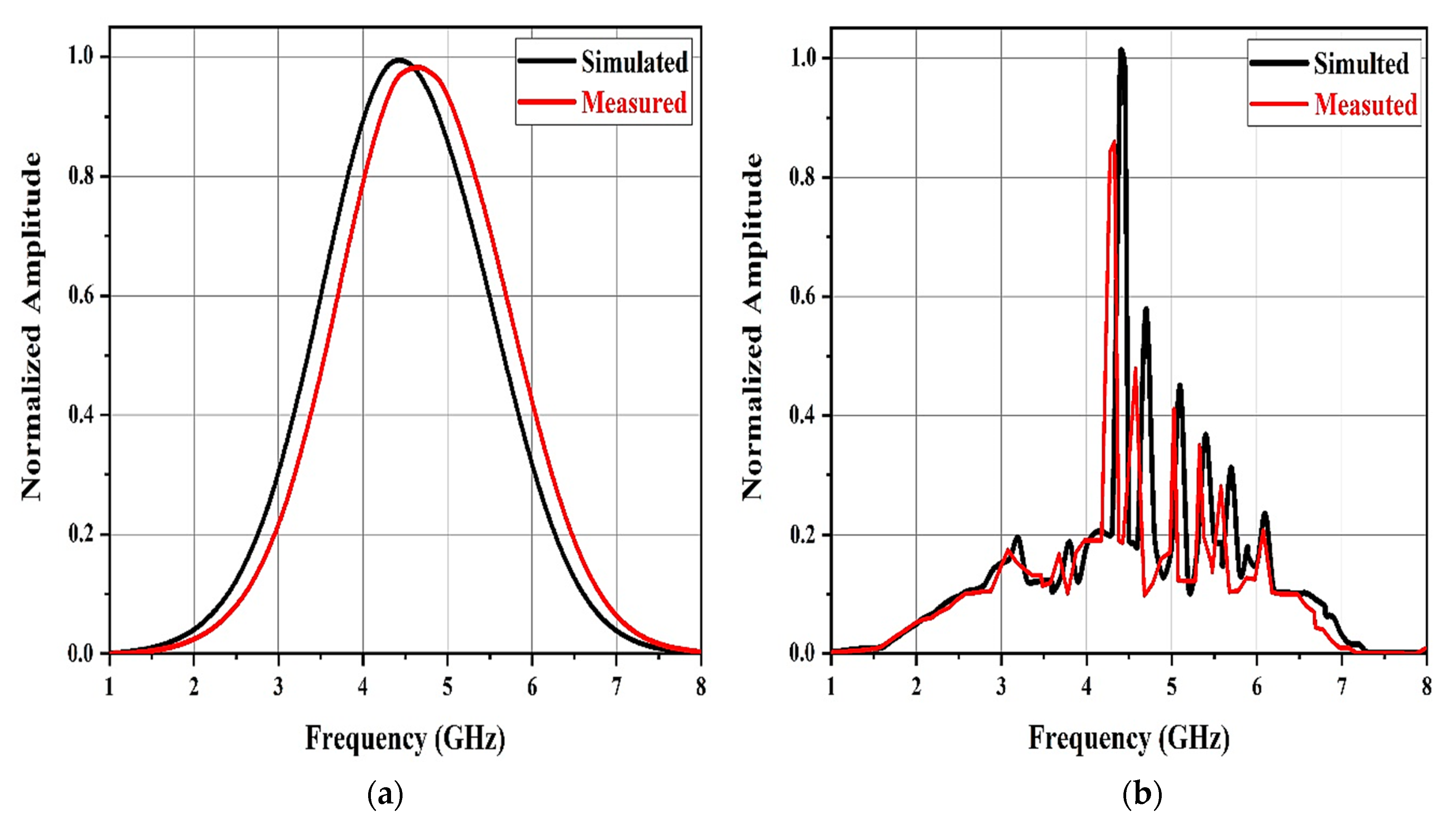

Publisher’s Note: MDPI stays neutral with regard to jurisdictional claims in published maps and institutional affiliations. |
© 2021 by the authors. Licensee MDPI, Basel, Switzerland. This article is an open access article distributed under the terms and conditions of the Creative Commons Attribution (CC BY) license (https://creativecommons.org/licenses/by/4.0/).
Share and Cite
Mekki, K.; Necibi, O.; Dinis, H.; Mendes, P.; Gharsallah, A. Frequency-Spectra-Based High Coding Capacity Chipless RFID Using an UWB-IR Approach. Sensors 2021, 21, 2525. https://doi.org/10.3390/s21072525
Mekki K, Necibi O, Dinis H, Mendes P, Gharsallah A. Frequency-Spectra-Based High Coding Capacity Chipless RFID Using an UWB-IR Approach. Sensors. 2021; 21(7):2525. https://doi.org/10.3390/s21072525
Chicago/Turabian StyleMekki, Kawther, Omrane Necibi, Hugo Dinis, Paulo Mendes, and Ali Gharsallah. 2021. "Frequency-Spectra-Based High Coding Capacity Chipless RFID Using an UWB-IR Approach" Sensors 21, no. 7: 2525. https://doi.org/10.3390/s21072525
APA StyleMekki, K., Necibi, O., Dinis, H., Mendes, P., & Gharsallah, A. (2021). Frequency-Spectra-Based High Coding Capacity Chipless RFID Using an UWB-IR Approach. Sensors, 21(7), 2525. https://doi.org/10.3390/s21072525






